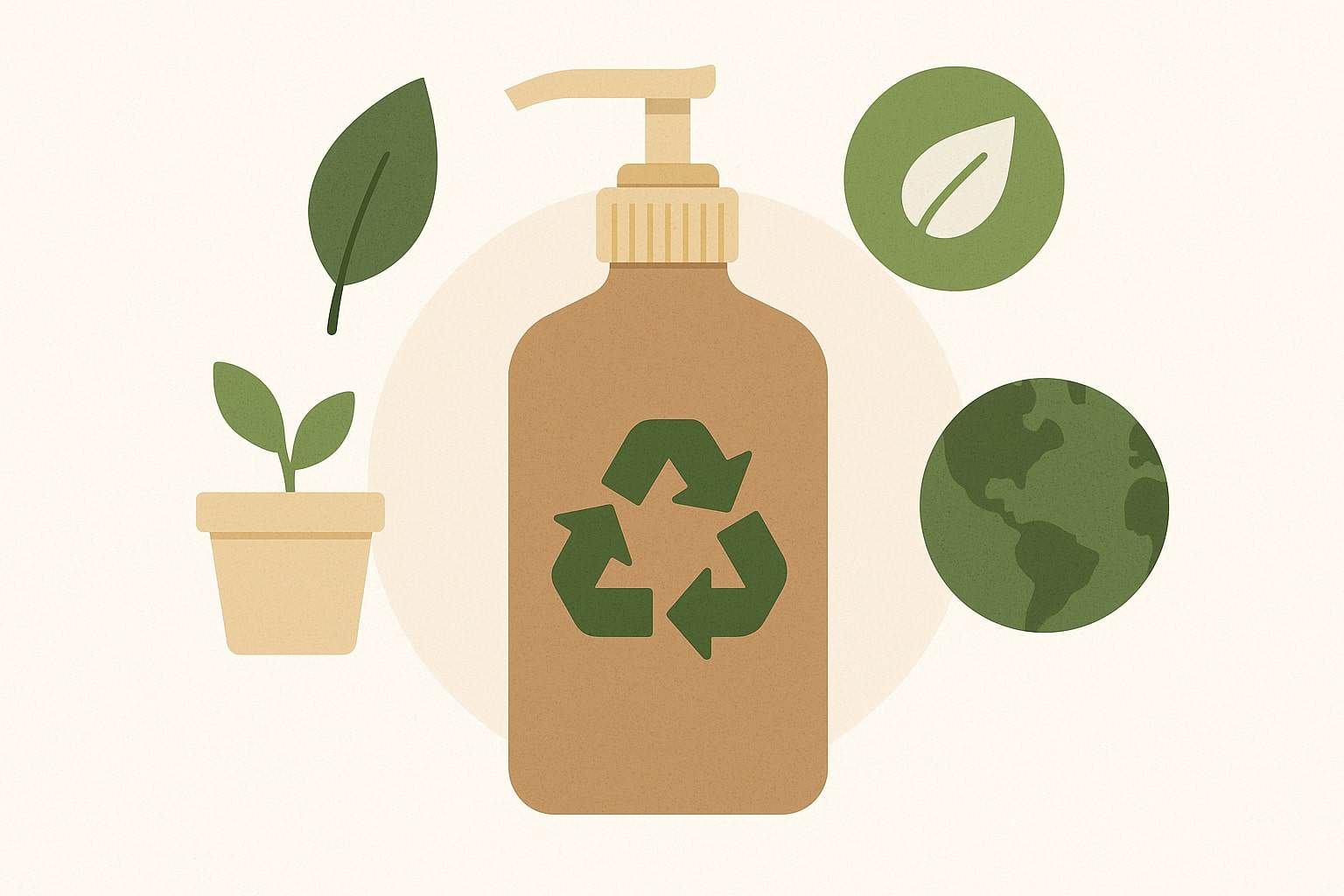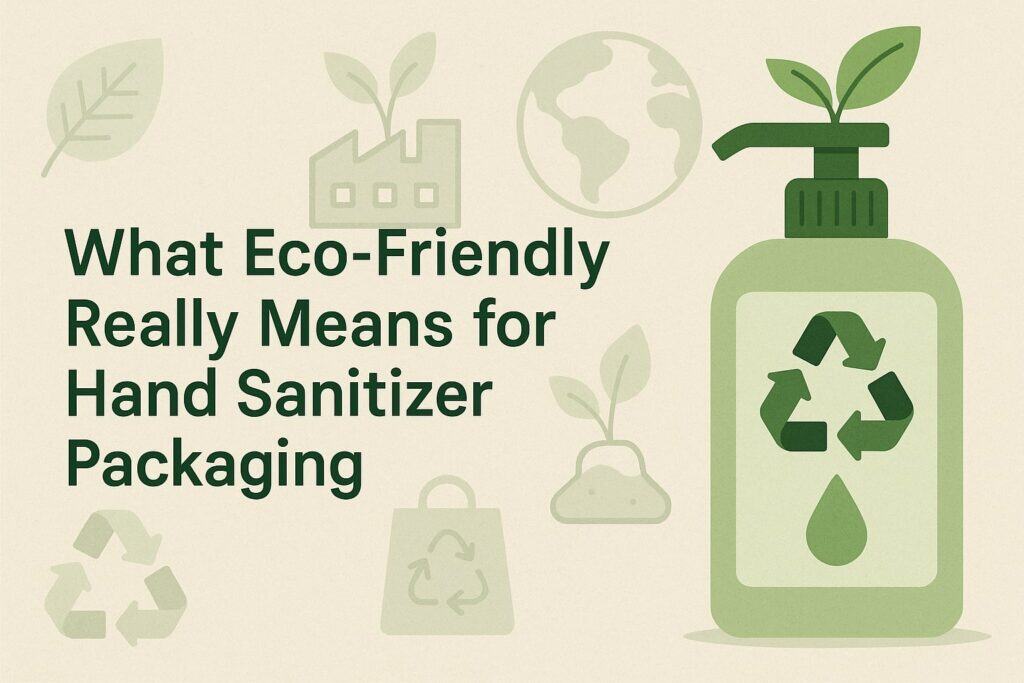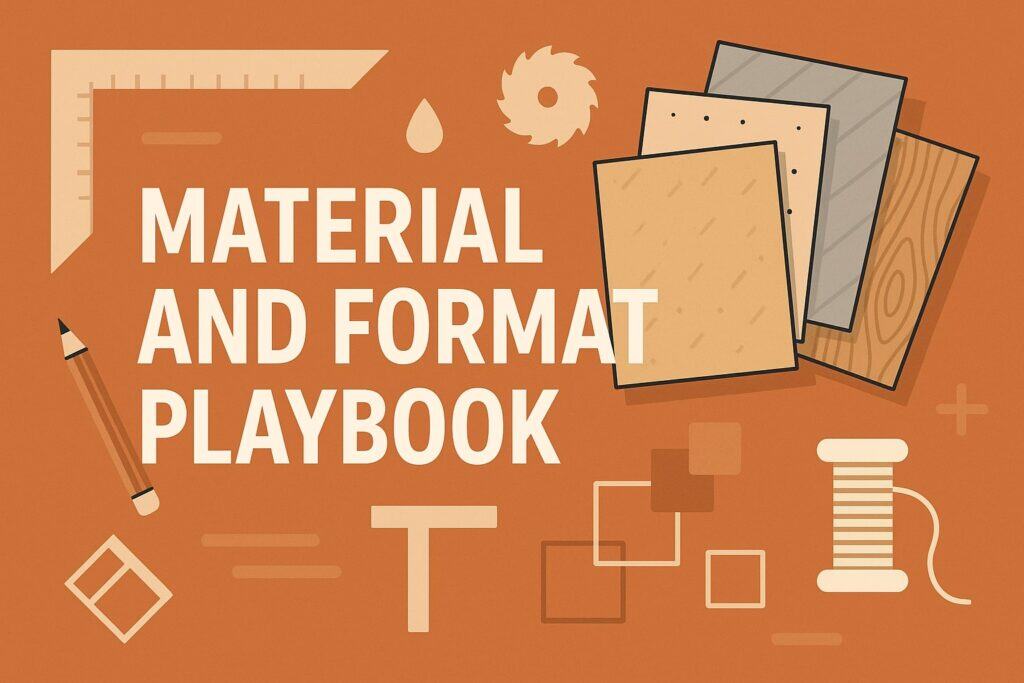
By myhandsanitizershop September 30, 2025
Switching to eco-friendly hand sanitizer packaging isn’t just a feel-good move—it’s a practical way to reduce waste, differentiate your brand, and often lower total landed cost through smarter materials and logistics.
The good news is there are now robust, professional sources for sustainable bottles, closures, pouches, labels, and refill systems across a wide range of volumes—from small-batch apothecaries to national retail brands.
The trick is knowing where to search, which materials are truly compatible with alcohol-based formulas, what certifications actually matter, and how to evaluate suppliers without burning time or budget.
This guide walks you through exactly that: where to find eco-friendly packaging, how to spot greenwashing, what to ask vendors, and how to build a future-proof packaging plan that aligns with both sustainability goals and regulatory requirements for flammable liquids.
You’ll also find step-by-step sourcing playbooks for small businesses and larger enterprises, plus practical advice on label adhesives, inks, and dispenser components that don’t sabotage recyclability.
By the end, you’ll have a concrete path to locate and qualify options like PCR (post-consumer recycled) PET and HDPE bottles, aluminum or glass formats, mono-material spouted pouches, fiber-based cartons, refill stations, and closed-loop take-back partners—along with the testing and compliance checklist you’ll need before you buy.
What “Eco-Friendly” Really Means for Hand Sanitizer Packaging (and What It Doesn’t)

Eco-friendly is not a single attribute; it’s a bundle of design choices that reduce harm across the package’s life cycle without compromising product safety.
For alcohol-based hand sanitizers (typically 60–80% ethanol or isopropanol), “eco-friendly” must start with material compatibility and regulatory compliance. A gorgeous bio-based resin that softens, leaches, or fails barrier requirements is not sustainable if it causes spoilage, spills, or recalls.
Prioritize fit-for-purpose performance first, then optimize for circularity. For rigid formats, the workhorse choices are PCR PET and PCR HDPE bottles because they’re widely recycled (check local streams), chemically resistant to alcohol, and now available with high post-consumer content (often 25–100%) with food-contact or cosmetic-grade options.
Aluminum bottles can be excellent for durability and refill systems and are highly recycled in many regions; glass provides premium aesthetics and infinite recyclability, but weight and breakage risk can increase transport emissions and costs.
Flexible mono-material pouches (e.g., PE-only structures) reduce plastic mass and cube dramatically, lowering freight emissions; they’re ideal for refill SKUs even if recycling streams are still developing in some markets.
Beyond the primary container, closures are critical. Choose pumps and triggers that are PP or PE dominant (ideally mono-material) to avoid mixed plastic streams that sabotage recycling. Look for springless pumps or designs with plastic springs to reduce metal contamination where possible.
If you must use metal springs, pick designs that are easy to separate. Specify tamper-evident bands, child-resistant closures where appropriate, and compatible liners (e.g., F217, polycone) that won’t degrade.
Labeling matters, too: use water-washable or recycling-compatible adhesives, minimal label real estate, and inks free of heavy metals. Shrink sleeves can lower recyclability unless designed with perforations and APR-recognized materials; paper labels are fine if adhesives and inks comply with recycling guidelines.
Eco-friendly also means verifiable. For compostable components, look for BPI/OK Compost (industrial) or certified home-compostable marks—but be cautious: most sanitizer formulas and supply chains are better served by recyclable or reusable formats than compostable plastics, which can be incompatible with alcohol and may only break down in managed facilities.
For fiber-based cartons and boxes, FSC certification validates responsible sourcing. For plastic content claims, insist on audited PCR percentages and chain-of-custody documentation.
And finally, eco-friendly should consider the logistics reality: lightweighting, nested or unassembled components, and concentrated refill strategies can cut emissions far more than a flashy but impractical material choice.
Material and Format Playbook: What to Buy (and When)

When you’re shopping, match the format to use case. For purse or travel sizes (30–100 mL), PCR PET or HDPE bottles with flip-top caps or mini-pumps balance durability with recyclability, while aluminum travel bottles excel for premium, refillable lines.
For everyday household or office dispensers (250–500 mL), PCR PET/HDPE or aluminum bottles with lockable pumps are the pragmatic standard. If your brand leans apothecary-chic, amber glass with a fine-mist sprayer looks great, but consider protective packaging to minimize breakage and evaluate shipping weight.
For refill SKUs (500 mL–1 L pouches; 1–5 L jerrycans), mono-material LDPE/HDPE pouches with spouts or handles can slash plastic weight, while PCR HDPE jugs offer robustness for B2B refills.
Institutional and retail back-of-house (5–20 L) are well served by PCR HDPE cubitainers or bag-in-box with high-barrier liners; these reduce cube and waste, enabling cost-effective refill stations.
Compatibility notes: ethanol and IPA can permeate or stress some bio-based resins; always request chemical compatibility data and run shelf-life tests at elevated temperatures (e.g., 40°C) to simulate real-world conditions.
For aluminum, specify food-safe internal lacquers that resist alcohol. For closures, verify gasket/liner compatibility and ask vendors for migration and extractables data where relevant; sanitizer is a personal-care product applied to skin, so your QA team should hold packaging to cosmetic-grade standards even if not strictly required.
If you’re exploring compostable films, test for alcohol hold-up, seal integrity, and shelf stability—many compostable films are fantastic for dry foods but not ideal for solvents.
Recyclability and end-of-life: prioritize mono-material designs (PET bottle + PET label or HDPE bottle + PE label) to reduce sortation losses. If you use paperboard secondary packaging, design for right-sizing and minimal coatings; water-based coatings are preferred over poly laminations.
Consider smart refill system choices: a durable pump bottle with recurring lightweight pouches often beats single-use rigid bottles across carbon and cost. If your market supports deposit or take-back, aluminum and glass perform well in closed loops—but ensure reverse logistics won’t negate gains.
Finally, aesthetics: sustainability shouldn’t feel like a downgrade. PCR resins once had color variability; modern suppliers can deliver near-virgin clarity or rich tints.
Embrace subtle cues like embossed “Refill & Recycle,” printed QR codes to localize recycling instructions, and measured dose pumps that reduce over-dispensing (which, by the way, reduces product waste and repeat purchases’ carbon footprint).
Where to Source: Supplier Types, Marketplaces, and Smart Search Tactics

Start with specialist sustainable packaging distributors; they curate PCR content, aluminum, glass, and mono-material pouches and will often pre-vet recyclability and compliance. Many now publish verified PCR percentages, liner specs, and compatibility notes with ethanol/IPA.
If you need small MOQs (minimum order quantities), look to boutique eco-packaging shops and maker-market platforms that carry 100–500 unit cases for pilots.
For mid-scale (1,000–25,000 units), national packaging distributors and regional bottle/jar suppliers can quote PCR content on standard molds and provide matching closures.
If you’re ready for custom, approach molders and converters who specialize in PCR resins; they can lightweight a standard bottle by 10–20% and still meet top-load requirements, which translates to significant material and freight savings.
For flexible refills, search terms like “mono-material PE spouted pouch sanitizer” or “recyclable PE pouch refill home care” will expose vendors focused on drop-in refill formats.
Bag-in-box and cubitainer suppliers are mainstays for jan/san (janitorial/sanitation) and foodservice; they’re used to alcohol products and can provide taps compatible with refill stations.
If you’d rather outsource everything, look for contract packagers (copackers) with turnkey eco options; many copackers now stock PCR bottles and recyclable pouches and can run small seasonal lots. Ask whether they can warehouse finished goods and kitted refill bundles (e.g., 1 pump bottle + 2 pouches) to simplify your e-commerce launches.
Don’t overlook printing and labeling partners. Narrow-web printers with experience in APR-recognized label stocks and wash-off adhesives are invaluable. They can recommend thin labels that don’t interfere with sortation optics or heavy-duty options for wet bathrooms that still delaminate in a recycling wash.
For paperboard, FSC-certified converters can right-size secondary cartons and add tear-away refill instructions. If you do retail, ask them about shelf-ready packaging (SRP) that’s curbside recyclable.
Where else to look? Sustainable business directories, trade associations in personal care and jan/san, and packaging trade shows often feature “sustainability pavilions” with clustered eco vendors.
University incubators and materials labs can connect you with startups commercializing novel barrier coatings or cap designs that eliminate metal springs.
For refill and zero-waste models, check networks of refill stores and bulk distributors; many supply white-label aluminum or glass dispensers plus refill carboys and signage, letting you trial a reuse program quickly.
Finally, keep an eye on specialty marketplaces focused on verified sustainable products; some include third-party audits and punitive delisting for greenwashing, which saves you diligence time.
How to Vet Claims and Avoid Greenwashing (A Practical Checklist)
Begin with claims you can verify. For PCR content, ask for audited documentation specifying the percentage and whether it’s post-consumer vs. post-industrial. Post-consumer typically delivers stronger environmental benefits and harder-won feedstock.
Confirm the grade (e.g., cosmetic, food-contact where relevant) and request resin lot traceability. For fiber-based components, request FSC or PEFC certificates and check that board coatings are water-based or minimal.
For compostables, demand certification numbers (BPI/OK compost) and a clear statement of conditions (industrial vs. home). If your product uses any compostable component, disclose end-of-life reality on pack so you’re not misdirecting customers in regions without access to facilities.
Compatibility is your next gate. Demand alcohol compatibility data for resins, liners, spouts, and seals. Run bench tests: fill, cap, invert, and store at elevated temperatures and under light exposure to stress the system.
Watch for paneling (vacuum collapse), swelling, odor transfer, or label failure. Test pumps for dose consistency and lock integrity; leaking pumps destroy sustainability gains by generating damages and returns.
Ask for UN/DOT packaging guidance if you ship high volumes of flammable liquids—your supplier should know their way around performance-oriented packaging (POP) codes for larger containers.
Recyclability proof points: look for APR (Association of Plastic Recyclers) Design® guidance compliance or equivalent regional standards. A supplier who speaks comfortably about label adhesives, density separation, and sortation is a good sign.
Avoid unnecessary pigments in PET (black can be problematic) and specify light-colored HDPE if possible. Ensure shrink sleeves are perforated for easy removal, and keep metallic inks to a minimum. For aluminum, confirm alloy and absence of problematic external coatings that could hinder recycling.
Operational diligence: scrutinize MOQs, lead times, and surge capacity. Sustainable lines can have longer lead times if feedstock is tight; build buffer inventory for launches. Confirm quality systems (ISO 9001 or equivalent), change-control processes, and defect remediation.
Ask about lifecycle data or LCAs; even if incomplete, a vendor who can discuss cradle-to-gate carbon and transport implications is investing in transparency. Lastly, negotiate sample runs and retainers so you can trial packaging in real fulfillment flows before rolling out nationally.
Cost, Carbon, and Logistics: Calculating the Real “Green” Win
Sticker prices can mislead. The true cost of eco-friendly packaging lives in total landed cost: resin per unit, shipping cube, damage/return rates, labor to assemble, and end-of-life fees or savings.
Flexible refills often look more expensive per kilogram of film than bottles per kilogram of plastic—but they may use 60–80% less material and ship in much denser cases, reducing freight costs and emissions.
Lightweighted PCR PET bottles can maintain performance while shaving grams; those grams multiply across pallets and lanes. Aluminum’s unit price is higher than plastic, but its infinite recyclability and premium feel can justify higher MSRP, and its refill durability can reduce reorders of primary packs.
To model carbon, start with a simple bill of materials (BOM): container, closure, label, secondary pack. For each, estimate mass, recycled content, and transport distance. If your distribution is e-commerce heavy, prioritize formats that reduce damage and leakage (returns multiply emissions).
Consider kitting a “starter + refill” bundle; it can reduce pick/pack touches and average shipping weight over multiple orders. Work with your 3PL to analyze dim weight improvements from pouches and collapsible bottles; fewer air gaps in cases translate to more units per truck.
Don’t forget the business upside: cleaner sustainability claims can unlock retail placement, corporate procurement wins, and government contracts with green purchasing mandates.
Clear on-pack instructions (“Keep cap on when recycling,” “Perforate sleeve and recycle bottle”) can improve consumer participation and reduce contamination fees. Over time, closing the loop with a take-back or refill program can reduce packaging spend volatility, particularly if resin prices spike.
Small-Business Sourcing Playbook: A Step-by-Step Path
- Step 1: Define constraints. List your sanitizer formula (ethanol/IPA %, viscosity, fragrance), target sizes (50 mL, 300 mL, 1 L refill), channels (DTC, wholesale), and positioning (premium, value, zero-waste). Decide what “eco” means for you now (e.g., 50%+ PCR in rigid packs, mono-material pouches for refills) with a roadmap to improve next year (e.g., 100% PCR, pump redesign).
- Step 2: Shortlist formats. Pick one rigid primary (e.g., 300 mL PCR PET with lock pump) and one refill (e.g., 1 L PE spouted pouch). Keep options tight to maintain buying power and reduce complexity.
- Step 3: Find suppliers. Search for “PCR PET bottle sanitizer,” “recyclable spout pouch refill PE,” “aluminum bottle pump cosmetic grade.” Target distributors offering low MOQs and quick samples. Ask for spec sheets, PCR documentation, and alcohol compatibility.
- Step 4: Sample & test. Run leak tests, drop tests, and hot-hold aging at 40°C. Check pump dose, child-resistance if relevant, and label adhesion after alcohol contact. Iterate quickly.
- Step 5: Nail the label and claims. Use recycling-compatible adhesives and minimal coverage. Add QR code with local recycling guidance and refill tutorials. Avoid ambiguous claims like “eco-plastic” without PCR percentage or certification.
- Step 6: Place phased orders. Start with a pilot (500–2,000 units), gather customer feedback on ergonomics and pump quality, monitor damage/return rates, then scale to 10k+ with negotiated pricing.
- Step 7: Plan refills early. Introduce refills within 60–90 days so early adopters can re-order sustainably. Offer bundle pricing to shift behavior.
- Step 8: Track metrics. Monitor cost per shipped unit, damages, and customer reviews about packaging. Use these to justify next-gen investments (e.g., springless pumps, higher PCR).
Enterprise & Institutional Strategy: Scale, Compliance, and Scope
Larger organizations should treat eco-friendly sanitizer packaging as a supply-chain program, not a one-off SKU tweak. Begin with a multi-format matrix (personal carry, desk, wall-mount, jan/san refill) and rationalize SKUs to simplify procurement.
Run formal LCAs or credible screeners to compare rigid PCR vs. aluminum vs. pouches in your distribution profile. Align packaging specs with corporate EPR (extended producer responsibility) requirements in your markets; design for recyclability guidelines (e.g., APR) and upcoming labeling laws that may restrict misleading recyclability claims.
Create dual-sourced BOMs (two bottle vendors, two closure vendors, two label stocks) to reduce risk, especially for PCR feedstock crunches.
Standardize testing: institute compatibility, aging, and transport validation protocols; require suppliers to notify you of resin or liner changes. Establish supplier scorecards covering recycled content, defect rates, and lead time adherence. F
or refill and reuse, pilot closed-loop systems at campuses or retail chains using aluminum or durable PET dispensers plus back-of-house bag-in-box; track dispenser lifetime and cleaning SOPs.
Build data capture for Scope 3 reporting: recycled content tonnage, packaging mass reduction, and % of orders fulfilled with refills rather than new primaries. Finally, coordinate with EHS and logistics on UN/DOT and hazmat shipping training; ensure packaging performance certificates are on file for bulk formats.
Design for Circularity: Labels, Inks, Adhesives, and Pumps That Don’t Undermine Recycling
Even the best bottle can be defeated by the wrong label or pump. Keep to mono-material where possible: PET bottle + PET label with wash-off adhesive, or HDPE bottle + PE label.
Choose adhesives that release in standard recycling wash conditions; your label printer can specify APR-compliant options. Use minimal label coverage to preserve optical sortation, avoid metallic inks and heavy foils, and perforate shrink sleeves for easy removal.
For pumps, ask about plastic spring designs to reduce metal contamination, or ensure easy disassembly instructions are available for reuse programs. Specify cap tethering where required by law, but verify the hinge doesn’t interfere with MRF sortation.
Consider refill-first graphics: instructions on how to refill, store, and recycle components. Include measurement marks on bottles to prevent over-concentrated or diluted mixtures for concentrated refills.
If you run wall-mount dispensers, pick universal refill connectors to avoid locking customers to a single source; that flexibility keeps systems in use longer and reduces waste.
On secondary packaging, right-size cartons and switch to curbside-recyclable board with water-based coatings, using paper-based tapes to avoid plastic contamination. Add a QR code to show local recycling guidance by ZIP/postcode, because rules can vary widely.
Compliance & Safety Essentials for Alcohol-Based Products
Alcohol-based sanitizers are flammable; your packaging and shipping must reflect that. For consumer volumes, you’ll typically be within limited quantity thresholds, but closures should still be secure and tamper-evident.
For bulk refills and B2B distribution, confirm UN performance packaging where applicable, and train your team on labeling, documentation, and storage. Ensure SDS (safety data sheets) accompany wholesale shipments and that your packaging materials won’t alter hazard classifications.
For e-commerce, add secondary containment (poly bag or corrugated insert) that’s curbside recyclable and designed to catch leaks without turning into mixed-material waste.
Test your packaging in real courier systems (vibration, temperature swings, and drop shocks) because a small increase in damage rate can erase sustainability gains and sour customer trust.
FAQs
Q.1: What’s the most sustainable material for hand sanitizer bottles—aluminum, glass, or PCR plastic?
Answer: There isn’t a one-size-fits-all winner, because “most sustainable” depends on your specific product, distribution, and end-of-life reality. Aluminum boasts very high recycling rates in many markets and can be refilled for years without quality loss; it’s rugged, dent-tolerant, and infinitely recyclable.
That makes it a strong candidate for refill and reuse systems, especially for on-the-go or workplace dispensers that take a beating. The trade-offs are higher upfront cost, the need for an internal lacquer compatible with alcohol, and potential denting that some customers perceive as damage rather than character.
Glass offers a premium feel and clarity, and like aluminum, it’s infinitely recyclable—but it is heavy and fragile. Shipping emissions and breakage risk can outstrip the benefits in certain e-commerce or long-haul scenarios, and many facilities still landfill small broken glass.
It shines in short, closed loops—think boutique retail with local refills—where reverse logistics are simple and protective secondary packaging is reusable.
PCR plastic (especially PET and HDPE) often lands as the pragmatic middle ground. Modern PCR grades can achieve a near-virgin appearance, are compatible with alcohol formulas, and integrate seamlessly into mass manufacturing.
They’re light, durable, and in many municipalities, readily recyclable. Because they reduce transport emissions and breakage without sacrificing recyclability, PCR plastics often deliver the best carbon-per-use outcome for mainstream distribution.
The key is thoughtful design: high PCR content with verified documentation, mono-material labels and caps, and clear “recycle me” guidance on pack.
For many brands, a hybrid strategy works best: a durable PCR or aluminum primary dispenser paired with lightweight mono-material refill pouches that slash total plastic and freight CO₂.
Q.2: Are compostable or biodegradable plastics a good idea for sanitizer packaging?
Answer: Compostable and biodegradable claims are tempting, but they rarely suit alcohol-based sanitizers. Many compostable films and resins are engineered for food or yard-waste contexts, not solvent-rich liquids.
Alcohol can weaken seals or permeate films, and even when performance is acceptable, end-of-life infrastructure is the stumbling block: industrial composting access varies by city, and composters often reject packaging, focusing on food and yard waste.
If a compostable pack ends up in landfill (anaerobic), it won’t degrade as advertised, undermining the environmental promise and risking accusations of greenwashing. That said, compostables can be effective for secondary packaging like paper-based fillers or compostable shipping mailers that avoid plastic.
For primary sanitizer containers, a circular approach—recyclable mono-materials, high PCR content, and refill systems—typically outperforms compostables on both practicality and real-world impact.
If you’re committed to exploring compostables, proceed with rigorous testing. Demand third-party certifications (BPI, OK Compost) and verify compatibility with your exact formula, including fragrances and humectants like glycerin that can alter interactions.
Pilot in a region where industrial composting is accessible, and educate customers clearly on disposal routes. Provide alternate recycling/refill options for customers outside those regions.
In most cases, your resources are better spent on improving recyclability, reducing material mass, and building refills that steer customers away from repeat single-use primaries.
Q.3: How can small brands keep costs down while switching to sustainable packaging?
Answer: Think systems, not pieces. The biggest savings usually come from reducing material and freight, not from chasing the cheapest bottle. Start with lightweighting and cube efficiency: a 300 mL PCR PET bottle with a compact pump and a 1 L PE refill pouch can cut plastic use per lifetime by more than half compared to buying three new bottles.
Bundling a “starter + two refills” kit reduces pick/pack touches and shipping emissions; customers appreciate value and convenience. Standardize components—choose one neck finish (e.g., 28/410) across sizes so you can buy pumps in bulk and swap between bottles.
Lean on distributor stock molds instead of custom tooling while you validate demand; you’ll save thousands and accelerate lead times. Use simple, recyclable labels (thin film with wash-off adhesive) and keep decoration minimal to reduce print costs.
On the sourcing side, order in phases: pilot, learn, scale. Lock pricing tiers with your distributor based on forecasted quarterly volume, and ask about mixed-SKU price breaks (e.g., combining 300 mL bottles and 1 L pouches).
Align launches with supplier production cycles to avoid rush fees. If cash flow is tight, consider vendor-managed inventory or 3PLs with co-packing who can hold some inventory closer to customers, reducing your freight spend.
Finally, capture the marketing upside: customers will pay a modest premium for verified PCR content, durable dispensers, and honest sustainability. Clear on-pack claims and refill education can lift repeat purchases and lower customer acquisition costs through word-of-mouth—value that easily offsets a few cents more per unit on the packaging itself.
Conclusion
Finding eco-friendly hand sanitizer packaging is no longer a scavenger hunt; it’s a structured procurement process with mature options across rigid and flexible formats.
Start with what matters most for sanitizers—alcohol compatibility and leak-free performance—then design for circularity using PCR resins, aluminum for durability, and mono-material refill pouches that collapse shipping emissions.
Source from specialist distributors, pouch converters, and turnkey copackers who understand recyclability standards and can document PCR content and certifications. Vet claims, test thoroughly under temperature and transport stress, and right-size your labeling so it helps recycling instead of hindering it.
Small brands can win through standardization, lightweighting, and refill-first bundles; larger enterprises should institutionalize LCAs, dual-sourcing, and closed-loop pilots tied to Scope 3 reporting.
Do this, and you’ll deliver packaging that feels premium, performs reliably, and actually reduces environmental impact—without blowing up your budget or your timeline. If you want, I can tailor a short vendor shortlist and testing plan to your formula, sizes, and sales channels next.